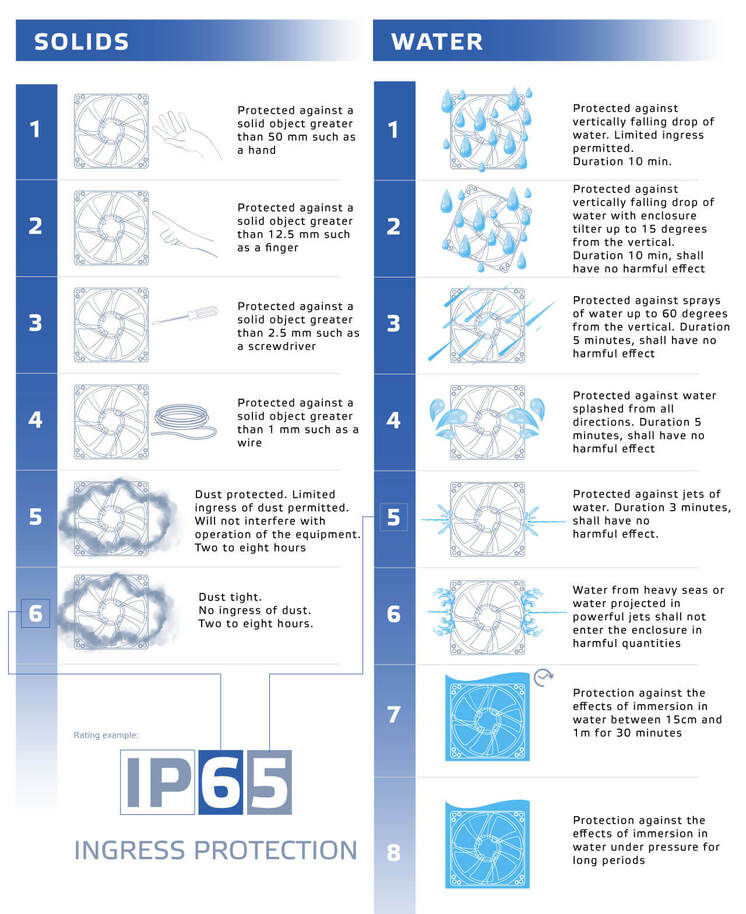What is IP protection?
Protection against ingress of solid objects and liquids
IP rating stands for “Ingress Protection rating”. However, sometimes, “International Protection rating” is given as its full equivalent. It classifies the degree of protection provided by the device enclosure against both solid objects and liquids. Electric equipment can malfunction and deteriorate when dust or water enters it. The IP rating is important when you buy a product. It is a useful tool to determine in which environments a product can be used.
Two digits
The IP rating consists of two digits that classify the level of protection provided in each case. The first digit refers to the level of protection against dust and solid objects. It has a minimum value of 0 (no protection) and a maximum value of 6 (maximal protection). The second digit refers to the level of protection against water and other liquids. It has a minimum value of 0 (no protection) and a maximum value of 9 (protection from hot, high-pressure liquids from different angles).
IP ratings of Sentera products
Sentera products are available in enclosures with different IP ratings, dependent on the model range and the required specifications. Consult the product datasheets for further information on available model ranges. We have given a summary of the available IP ratings for Sentera products below.
IP20 enclosures provide some protection from accidental contact from hands/fingers and no protection against the ingress of dust, water or other liquids into the product’s enclosure. These devices are designed to be installed in an electrical cabinet with sufficient ventilation and cooling possibilities.
IP30 enclosures protect against contact with hands/fingers and smaller objects (e.g. a screwdriver). They do not offer protection against the ingress of dust, water or other liquids into the product’s enclosure. These devices are designed for indoor applications.
IP44 enclosures protect against contact with particles or solid objects with a diameter of no less than 1,0 mm. It also protects the device from splashes of water, sprayings, and water drops. These devices are designed for indoor applications.
IP54 enclosures protect against the ingress of dust to the point of preventing the ingress of anything potentially harmful to the internal workings of the device. On top of that, the enclosure also withstands water splashing from different directions (no water jets). These devices are designed for applications in harsher environments. However, they should be protected against water drips and direct sunlight with a cover.
IP65 enclosures are rated as completely dust-tight and protected against exposure to water jets from any direction. These devices are designed for outdoor applications.
IP66 enclosures are completely dust-tight. No dust or other harmful solid materials can enter the device. It protects from powerful water jets directed at the device from anywhere. These devices are designed for harsh outdoor applications.
IP67 enclosures are completely dust-tight. Nothing solid can enter the device. The enclosure also protects the device against temporary immersion in water. These devices are designed for harsh outdoor applications, and are especially useful in industrial or agricultural settings.
The level of IP protection that your application requires depends on your application and the conditions to which the Sentera device will be exposed. Local regulations may apply to your application. Generally, if unsure, always seek advice and elect to go with the higher IP rating.
History of the IP rating system
The International Electro technical Commission (IEC) developed the IP code. The code is defined by the international standard IEC 60529. This standard was prepared by IEC Technical Committee 70 in 1976, and was last revised in 2019. The standard applies to all electrical equipment with a rated voltage of no more than 72,500 V. The reason for its creation was the fact that there were multiple rating standards in use. The committee wanted to create a universal tool and they have succeeded in that regard.

